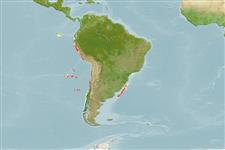>
Anguilliformes (Eels and morays) >
Congridae (Conger and garden eels) > Congrinae
Etymology: nielseni: Named in honor of Jorgen Nielsen, famous specialist of deep-sea fishes..
Environment: milieu / climate zone / depth range / distribution range
Ecología
marino batidemersal; rango de profundidad 160 - 340 m (Ref. 41744). Deep-water
Southeast Pacific: central and southern part of the Nazca Ridge.
Tamaño / Peso / Age
Maturity: Lm ? range ? - ? cm
Max length : 46.5 cm TL macho / no sexado; (Ref. 41744)
Short description
Morfología | Morfometría
Espinas dorsales (total): 0; Radios blandos dorsales (total): 272-324; Espinas anales 0; Radios blandos anales: 198 - 217; Vértebra: 151 - 153. Median fins with dark margins; dorsal fin origin above the upper base of the pectoral or slightly anterior; anal fin origin at a point 1.3-1.5 times HL from the gill aperture; lateral line system: supraorbital 3, infraorbital 5, preopercular-mandibular 9, occipital commissure 3 (Ref. 41744).
Life cycle and mating behavior
Madurez | Reproducción | Puesta | Huevos | Fecundidad | Larva
Karmovskaya, E.S., 1990. New species of conger eels from southeastern Pacific Seamounts. J. Ichthyol. 30(7):1-10. (Ref. 41744)
IUCN Red List Status (Ref. 130435)
Threat to humans
Harmless
Human uses
Más información
Nombres comunesSinónimosMetabolismoDespredadoresEcotoxicologíaReproducciónMadurezPuestaAgregación para la puestaFecundidadHuevosEgg development
Age/SizeCrecimientoLength-weightLength-lengthLength-frequenciesMorfometríaMorfologíaLarvaDinámica larvariaReclutamientoAbundanciaBRUVS
ReferenciasAcuiculturaPerfil de acuiculturaRazasGenéticaElectrophoresesheritabilidadEnfermedadesProcesamientoNutrientsMass conversion
ColaboradoresImágenesStamps, Coins Misc.SonidosCiguateraVelocidadTipo de nataciónSuperficie branquialOtolitosCerebrosVisión
Herramientas
Special reports
Download XML
Fuentes de Internet
Estimates based on models
Preferred temperature (Ref.
123201): 9.8 - 13.2, mean 11.6 °C (based on 11 cells).
Phylogenetic diversity index (Ref.
82804): PD
50 = 0.5625 [Uniqueness, from 0.5 = low to 2.0 = high].
Bayesian length-weight: a=0.00062 (0.00028 - 0.00136), b=3.19 (3.00 - 3.38), in cm total length, based on LWR estimates for this (Sub)family-body shape (Ref.
93245).
Nivel trófico (Ref.
69278): 3.9 ±0.5 se; based on size and trophs of closest relatives
Resiliencia (Ref.
120179): Medio, población duplicada en un tiempo mínimo de 1.4-4.4 años (Preliminary K or Fecundity.).
Fishing Vulnerability (Ref.
59153): Moderate vulnerability (37 of 100).
